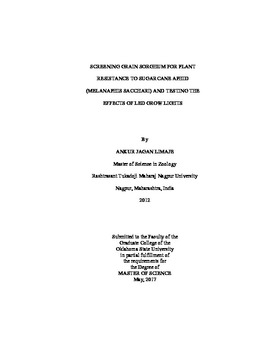| dc.contributor.advisor | Hoback, William Wyatt | |
| dc.contributor.author | Limaje, Ankur Jagan | |
| dc.date.accessioned | 2018-04-24T13:02:23Z | |
| dc.date.available | 2018-04-24T13:02:23Z | |
| dc.date.issued | 2017/5/1 | |
| dc.identifier.uri | https://hdl.handle.net/11244/299666 | |
| dc.description.abstract | Sorghum, Sorghum bicolor, is increasing importance as human food, animal forage, and a source for biofuel production. Since 2013, sugarcane aphid, Melanaphis sacchari has become a perennial and significant pest in the southern United States. Natural plant resistance to this pest offers the best option for sustainable low-cost management. Screening for the resistance of cultivars is usually conducted in greenhouse trials where plants are grown in controlled environments and infested with aphids from a colony of M. sacchari. The recent adoption of LED pink growth lights at The United States Department of Agriculture greenhouses in Stillwater OK has reduced energy costs. However, sorghum plants grown under these certain types of lights appeared to be different with more leaves, shorter height, and chlorosis compared to plants grown under normal light. I conducted experiments using known resistant and known susceptible sorghum lines that were grown under normal and LED lights. Plants grown under pink light had more root and aboveground biomass, but were shorter with fewer leaves, and exhibited less chlorophyll than the same plants grown under conventional lights. When infested with aphids, both growing conditions supported a similar number of aphids but plants grown under LEDs had higher damage ratings than those under conventional lights. Based on the results of this experiment, greenhouse trials used to detect sorghum resistance should not use pink LED lights. In the second set of experiments, sorghum lines obtained from a Texas breeder were screened for resistance to sugarcane aphid. Replicated trials were conducted with 34 sorghum lines for compared with two known resistant and two known susceptible lines respectively. Based on these trials, two new lines were identified as having resistance. The second set of trials focused on these lines and quantified aphid survival, reproduction and population growth. The two newly identified pollinator lines, R.11143 and R.11259 exhibited substantial antibiosis and are recommended to be used in breeding programs for developing resistant sorghums threatened by the sugarcane aphid. | |
| dc.format | application/pdf | |
| dc.language | en_US | |
| dc.rights | Copyright is held by the author who has granted the Oklahoma State University Library the non-exclusive right to share this material in its institutional repository. Contact Digital Library Services at lib-dls@okstate.edu or 405-744-9161 for the permission policy on the use, reproduction or distribution of this material. | |
| dc.title | Screening Grain Sorghum for Plant Resistance to Sugarcane Aphid (Melanaphis sacchari) and Testing the Effects of LED Grow Lights | |
| dc.contributor.committeeMember | Zarrabi, Ali A. | |
| dc.contributor.committeeMember | Armstrong, John Scott | |
| osu.filename | Limaje_okstate_0664M_15240.pdf | |
| osu.accesstype | Open Access | |
| dc.description.department | Entomology & Plant Pathology (MS) | |
| dc.type.genre | Thesis | |
| dc.type.material | text | |
